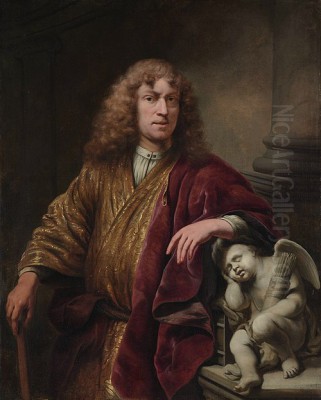
Ferdinand Bol stands as a significant figure in the constellation of artists defining the Dutch Golden Age. Born in Dordrecht in 1616, he moved to the bustling metropolis of Amsterdam, the heart of Dutch commerce and culture, where he would spend the majority of his productive life until his death in 1680. His journey from an aspiring artist to one of the most sought-after painters in Amsterdam is a story intertwined with the towering figure of his master, Rembrandt van Rijn, and the evolving tastes of the Dutch Republic's elite. Bol navigated the complex art world of his time, mastering portraiture and history painting, leaving behind a body of work that reflects both profound influence and a distinct artistic personality.
Early Life and Apprenticeship with Rembrandt
Ferdinand Bol's artistic path began in his birthplace, Dordrecht, a city with its own artistic traditions. However, the magnetic pull of Amsterdam, the epicenter of the Dutch art market and home to the era's most celebrated painter, Rembrandt, proved irresistible. Around 1635 or 1636, Bol made the pivotal move to Amsterdam and entered Rembrandt's thriving workshop. This was not merely a place of instruction but a dynamic environment where assistants learned by doing, contributing to the master's commissions while honing their own skills.
Bol's apprenticeship, lasting until approximately 1641, was formative. He absorbed Rembrandt's revolutionary approach to painting, particularly his dramatic use of light and shadow (chiaroscuro), his textured brushwork, and his deep psychological insight into human subjects. Rembrandt emphasized concepts like 'houding' (the correct rendering of form and spatial relationships through tonal values) and 'schikschaduw' (the artful arrangement of shadows), principles Bol clearly mastered. He became one of Rembrandt's most adept pupils, working alongside other talented young artists who passed through the studio, such as Govert Flinck, Gerbrand van den Eeckhout, and Carel Fabritius.
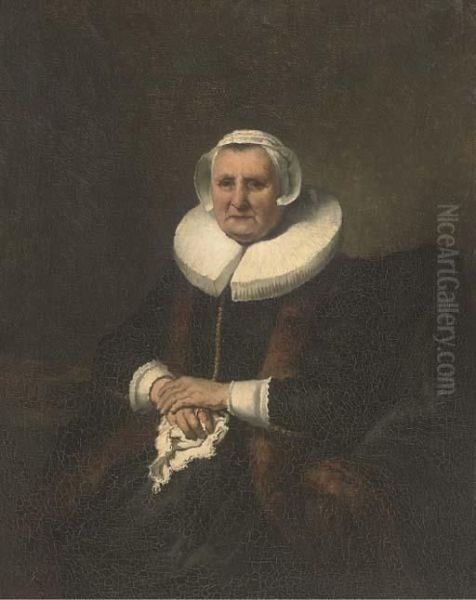
The training under Rembrandt was rigorous and comprehensive. Pupils learned not only painting techniques but also drawing, etching, and the business side of art – managing commissions, dealing with patrons, and running a studio. Bol's time in this environment equipped him with the technical prowess and artistic understanding necessary to launch his own successful career. The influence of these early years would remain palpable throughout his work, even as he later developed his own distinct style.
The Rembrandt Problem: Early Style and Attribution
During his time in Rembrandt's studio and in the years immediately following his departure (roughly the early 1640s), Bol's style adhered so closely to his master's that distinguishing their hands can be exceptionally challenging for art historians even today. This phenomenon, sometimes referred to as the "Rembrandt problem," highlights Bol's remarkable ability to emulate the complex compositions, rich, dark palettes, and dramatic lighting characteristic of Rembrandt's work from the late 1630s and early 1640s.
Bol painted portraits, biblical scenes, and historical subjects, mirroring Rembrandt's thematic interests. His figures often possess a similar emotional weight and presence, rendered with comparable brushwork and tonal depth. This stylistic proximity has led to numerous attribution debates over the centuries. Works once confidently assigned to Rembrandt have been reattributed to Bol, and vice versa, based on ongoing research, connoisseurship, and technical analysis.
A prime example often cited in discussions of Bol's early, Rembrandt-esque style is the powerful Portrait of Elisabeth Bas (c. 1642, Rijksmuseum, Amsterdam). For a long time, this sensitive portrayal of an elderly woman was considered a quintessential Rembrandt. However, stylistic nuances and comparisons with Bol's signed works from the period have led many scholars to attribute it firmly to Bol, showcasing his mastery of the Rembrandtesque idiom at the very outset of his independent career. This painting demonstrates the profound impact of his training and his ability to compete at the highest level.
Forging an Independent Path: The 1640s
Around 1642, Ferdinand Bol established himself as an independent master in Amsterdam. While the shadow of Rembrandt still loomed large, the 1640s marked a period where Bol began to subtly assert his own artistic identity. He continued to work in the genres favored by his teacher – portraits and history paintings – but signs of a developing individual style started to emerge. His works from this decade often retain the strong chiaroscuro and emotional depth learned from Rembrandt, but one can sometimes detect a slightly smoother finish or a different approach to composition.
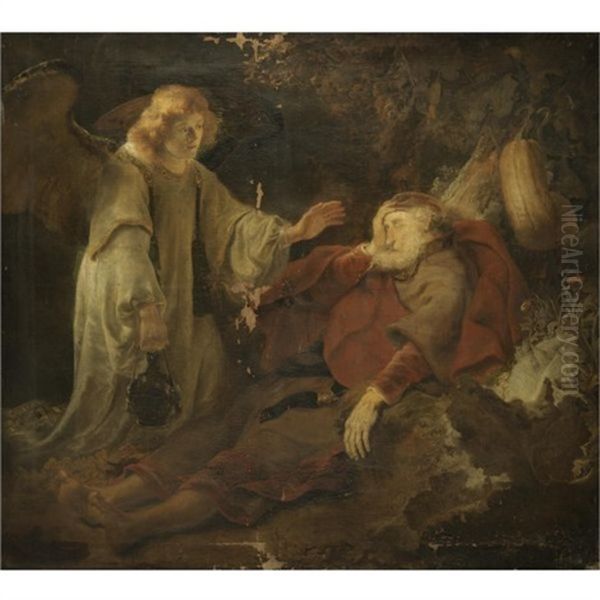
His Angel Appearing to Elijah (c. 1642, The Leiden Collection, New York) is an early independent work that still resonates with Rembrandtesque drama and lighting, yet shows Bol confidently handling a biblical narrative on his own terms. Similarly, his Man with a Book (1644, Nationalmuseum, Stockholm) displays the introspective quality often found in Rembrandt's portraits, executed with considerable skill.
This decade also saw Bol engage with self-portraiture, a genre his master famously explored. Bol's self-portraits from the 1640s are fascinating documents, not only charting his appearance but also his evolving artistic confidence. Some have sparked scholarly discussion regarding the identity of the sitter or the specific circumstances of their creation. An intriguing example is a self-portrait from around 1648 where Bol reportedly placed his signature cleverly on a piece of paper depicted within the painting, rather than directly on the canvas surface – a subtle departure from Rembrandt's typical practice and perhaps an early sign of his desire to differentiate himself.
Rise to Prominence: The 1650s and Civic Commissions
The 1650s marked a turning point in Ferdinand Bol's career, propelling him to the forefront of Amsterdam's art scene. A key factor in his ascent was his marriage in 1653 to Elisabeth Dell. Her family connections were impeccable; her father was associated with the Admiralty of Amsterdam, and her mother belonged to a prominent family in the wine merchants' guild. This marriage effectively integrated Bol into the city's affluent and influential social circles.
These connections translated into prestigious and lucrative commissions. Bol became a favored painter of the Amsterdam elite, receiving numerous portrait orders from wealthy merchants, regents, and officials. More significantly, he secured important commissions for public buildings, most notably the new Amsterdam Town Hall (now the Royal Palace). He was commissioned to create large-scale history paintings for its opulent interiors, including chimney pieces. Working on the Town Hall project, designed by architect Jacob van Campen, placed Bol alongside other leading artists of the day, such as his former fellow pupil Govert Flinck (who initially received the largest commissions before his untimely death) and later, even Rembrandt himself, though Rembrandt's contribution (The Conspiracy of Claudius Civilis) was ultimately rejected.
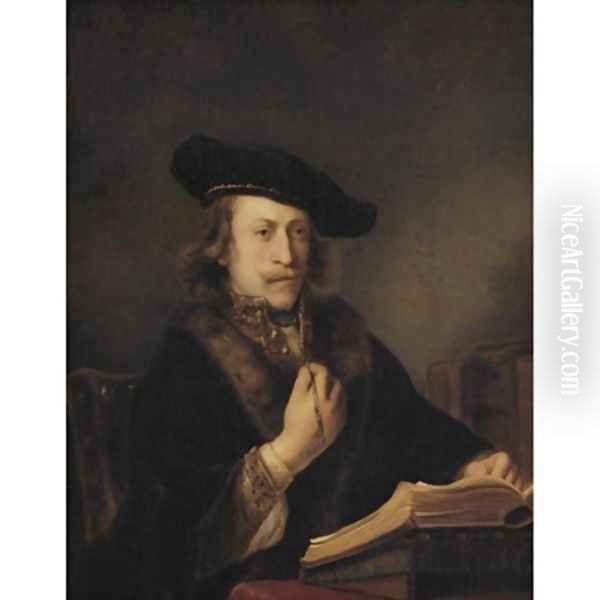
During this period of rising success, Bol's artistic style underwent a noticeable transformation. While retaining a foundation in Rembrandt's teachings, his work gradually moved away from the dark, intense drama of his early years towards a lighter, more colorful, and elegant aesthetic. This shift aligned with the changing tastes of Amsterdam's elite, who increasingly favored a more refined, classicizing, and internationally influenced Baroque style, exemplified by painters like Bartholomeus van der Helst, who had become Amsterdam's most fashionable portraitist. Bol adapted skillfully, demonstrating his versatility and business acumen.
Mature Style and Masterworks
By the mid-1650s and into the 1660s, Ferdinand Bol had fully developed his mature style, one that secured his reputation as one of Amsterdam's leading masters. This later style is characterized by greater elegance, smoother brushwork, a brighter and more varied color palette, and compositions that often feel more balanced and classical than his earlier, more intensely dramatic works. While still employing chiaroscuro, the contrasts are often less stark, and figures are frequently presented with a refined grace and idealized beauty.
His success was built on his proficiency in both major genres. In history painting, he tackled complex biblical, mythological, and allegorical subjects with confidence. Works like Moses Descending Mount Sinai with the Ten Commandments (c. 1662, Royal Palace, Amsterdam) exemplify his ability to handle large-scale narrative compositions for prestigious public spaces, employing looser brushwork where appropriate but maintaining clarity and impact. Venus and Adonis (1658, Rijksmuseum, Amsterdam) showcases his handling of mythology with a sensuous elegance typical of his mature phase.
Other notable history paintings demonstrating his range include Aeneas at the Court of Latinus (related works exist, showcasing his skill in light and color), the contemplative Sleeping Mars, and the intellectually engaging Allegory of Education. His religious paintings, such as The Holy Family, sometimes drew inspiration from compositions by Rembrandt (including his etchings), but reinterpreted them in Bol's smoother, more polished manner.
In portraiture, Bol continued to excel, capturing the likenesses of Amsterdam's wealthy citizens with flattering elegance. While perhaps lacking the raw psychological depth of Rembrandt's late portraits, Bol's portraits satisfied the desire of his patrons for dignified and sophisticated representations. Works like Woman with a Fan reflect this successful adaptation to the prevailing tastes, securing his position alongside rivals like Bartholomeus van der Helst. His ability to blend Rembrandtesque substance with contemporary elegance was key to his sustained success.
Bol as an Etcher
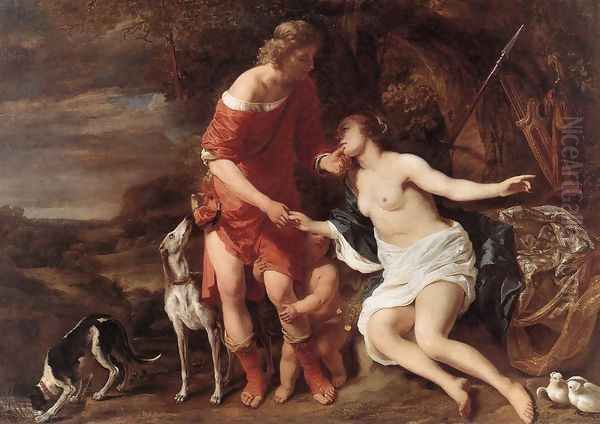
Beyond his prolific output as a painter, Ferdinand Bol was also a skilled etcher, though his work in this medium is less extensive than Rembrandt's. Having learned the technique in Rembrandt's workshop, Bol produced a number of etchings, primarily during the 1640s and early 1650s. His etched work often mirrors the subjects and stylistic concerns of his paintings from the same period.
His etchings include portraits, genre scenes, and biblical subjects. Like his early paintings, his initial etchings show a strong Rembrandtesque influence in their use of line, hatching, and dramatic lighting to create atmosphere and volume. He explored textures and tonal variations, demonstrating a clear understanding of the medium's potential.
Notable examples of his etched work include The Hour of Death (Museum Van Loon, Amsterdam), a poignant and reflective piece, and the charming Woman at a Window with a Pear (c. 1651, Harvard Art Museums), which displays a sensitivity to domestic intimacy. While Bol did not push the boundaries of etching technique as radically as Rembrandt did in his later years, his prints are accomplished works that stand on their own merit and contribute to our understanding of his artistic range. His activity as an etcher seems to have diminished as his painting commissions increased significantly in the 1650s.
Later Life, Remarriage, and Cessation of Painting
Ferdinand Bol's personal life saw significant changes in his later years. His first wife, Elisabeth Dell, who had been instrumental in his social ascent, died sometime before 1669 (sources vary, some place it closer to 1660). This loss may have impacted him deeply. However, his financial and social standing remained high. In 1669, he married Anna van Erckel (née van Arckel), the wealthy widow of the treasurer of the Admiralty. This marriage brought Bol considerable wealth and further solidified his position within Amsterdam's upper echelons.
Interestingly, around the time of his second marriage, Ferdinand Bol largely ceased painting. At the height of his fame and success, he effectively retired from his artistic practice. The reasons for this are not definitively known but are likely linked to his newfound wealth and social status. He no longer needed to paint for a living and may have preferred to live the life of a gentleman of leisure and engage in civic duties. He had already served as head of the wine merchants' guild, a position likely secured through his first wife's family. His second marriage perhaps provided the financial security and social standing to step away from the demanding life of a professional artist.
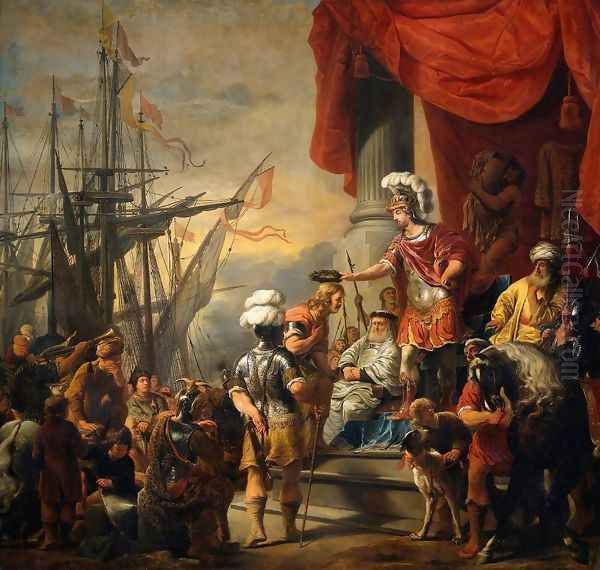
This cessation of artistic activity while still relatively young (in his early 50s) and successful is one of the intriguing aspects of Bol's biography. He lived for another decade, dying in Amsterdam in 1680, apparently content with his status as a respected citizen rather than a practicing painter. His later years seem to have been focused on managing his affairs and enjoying the comforts his successful career and advantageous marriages had afforded him.
Legacy and Collections
Ferdinand Bol's legacy is complex. As one of Rembrandt's most talented pupils, he played a crucial role in disseminating aspects of his master's style. However, he was also an adaptable artist who successfully modified his approach to meet the evolving demands of the Amsterdam art market, transitioning towards a more elegant, internationally influenced Baroque manner. In this sense, he can be seen as a bridge figure between the intense, personal style of Rembrandt and the smoother, more classicizing trends that gained favor in the latter half of the 17th century, represented by artists like Gerard de Lairesse.
While highly successful and respected during his lifetime, his reputation somewhat declined in subsequent centuries, often overshadowed by the towering genius of Rembrandt. The very closeness of his early style to Rembrandt's sometimes worked against him in the eyes of later critics, who might have perceived it as derivative. However, modern scholarship recognizes Bol's significant talent, his technical skill, and his importance within the context of the Dutch Golden Age. He was a master in his own right, capable of producing powerful history paintings and sensitive portraits that deeply resonated with his contemporaries.
Today, Ferdinand Bol's works are held in major museums around the world. The Rijksmuseum in Amsterdam holds a significant collection, including key works like the Portrait of Elisabeth Bas and Venus and Adonis. His paintings can also be found in the Royal Palace (formerly Town Hall) in Amsterdam, The Leiden Collection (New York), the Louvre Museum (Paris), the National Gallery (London), the Nationalmuseum (Stockholm), the Staatliche Museen zu Berlin, and many other institutions. His drawings and etchings are preserved in print rooms globally, including the Harvard Art Museums and the Staatliche Graphische Sammlung in Munich. These collections allow audiences today to appreciate the skill and artistry of this important Dutch master.
Unresolved Questions and Anecdotes
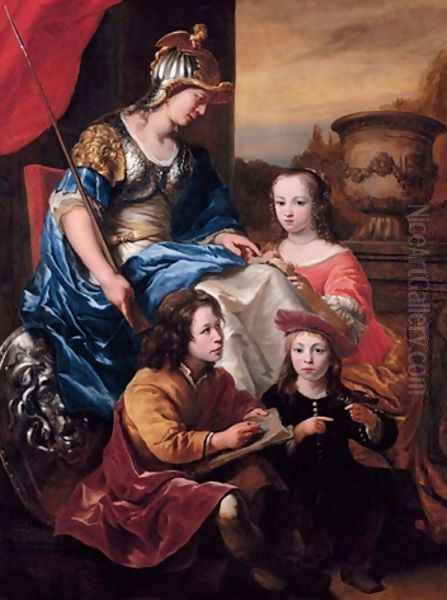
Despite his prominence, aspects of Ferdinand Bol's life and work remain subjects of discussion and mystery. The attribution issues surrounding his early work and Rembrandt's continue to be debated by scholars, requiring careful analysis of brushwork, composition, and provenance. The exact nature of his contribution within Rembrandt's workshop – whether he assisted on specific famous paintings like the debated Pearl Necklace double portrait – remains speculative.
The story of the five large paintings Bol created for a house in Utrecht, designed to cover entire walls and enhance the sense of presence of sculptures, is intriguing. While the commission itself is documented, the specific details, the appearance of the works, and their ultimate fate contribute to the unresolved facets of his oeuvre. Such large-scale decorative schemes were ambitious, and understanding their context fully remains a challenge.
The abrupt cessation of his painting career around 1669 continues to fascinate. While his wealthy second marriage provides a likely explanation, the psychological shift from a highly successful artist to a retired gentleman invites speculation. Furthermore, the fluctuating fortunes of his works on the art market over time, including the unfortunate destruction of one of his paintings in the Leiden Town Hall fire of 1929, add anecdotal layers to his posthumous history. These lingering questions and stories contribute to the enduring interest in Ferdinand Bol, an artist whose career reflects both the heights of artistic achievement and the complex interplay of talent, influence, and social circumstance in the Dutch Golden Age.
Conclusion
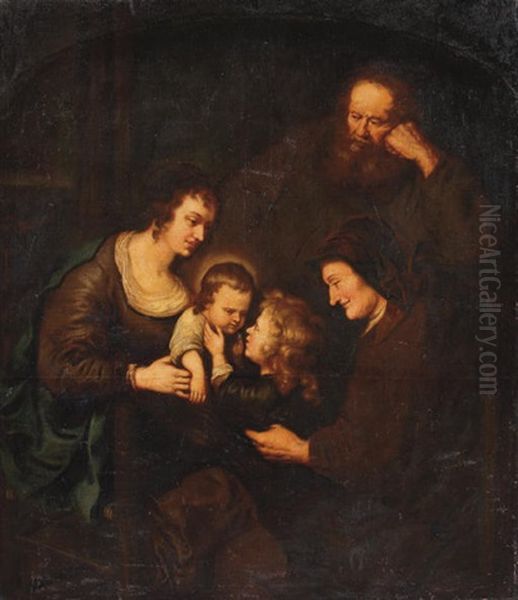
Ferdinand Bol remains a pivotal figure in 17th-century Dutch art. Emerging from the direct tutelage of Rembrandt van Rijn, he absorbed the master's dramatic power and technical brilliance. Yet, Bol was no mere imitator. He forged his own path, adapting his style to become one of the most successful and sought-after painters in Amsterdam during the peak of the Golden Age. His ability to navigate the demands of prestigious civic commissions and private patronage, shifting from an intense Rembrandtesque manner to a more elegant and refined Baroque style, speaks volumes of his artistic intelligence and adaptability. From compelling portraits like Elisabeth Bas to grand history paintings like Moses Descending Mount Sinai, Bol's work demonstrates consistent quality and skill. Though he chose to lay down his brushes relatively early in life, his substantial body of work secures his place as a significant master whose art continues to be studied and admired in collections worldwide. His career offers valuable insights into the dynamics of the Dutch art world, the enduring legacy of Rembrandt, and the evolving tastes of a prosperous republic.